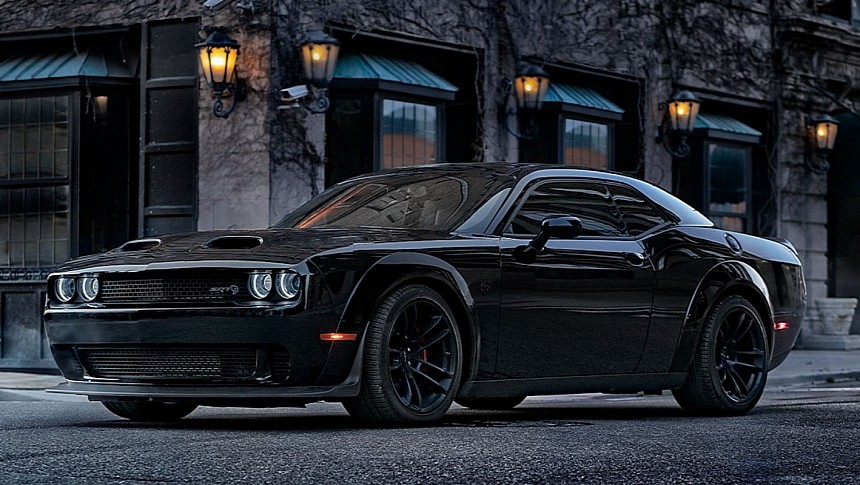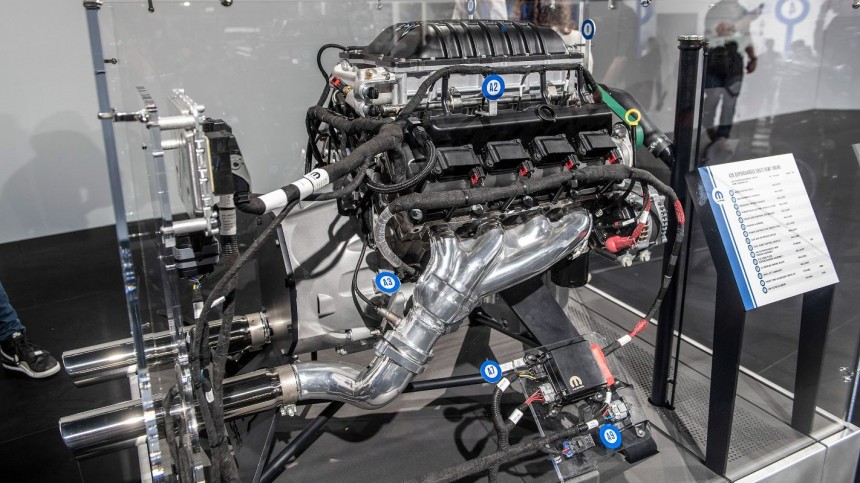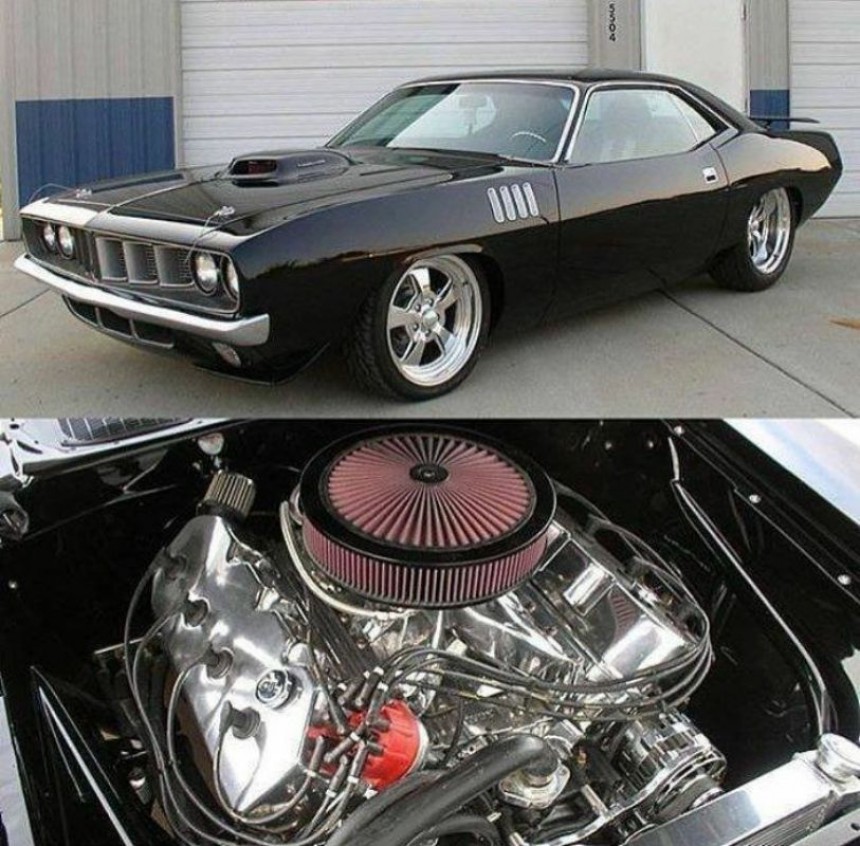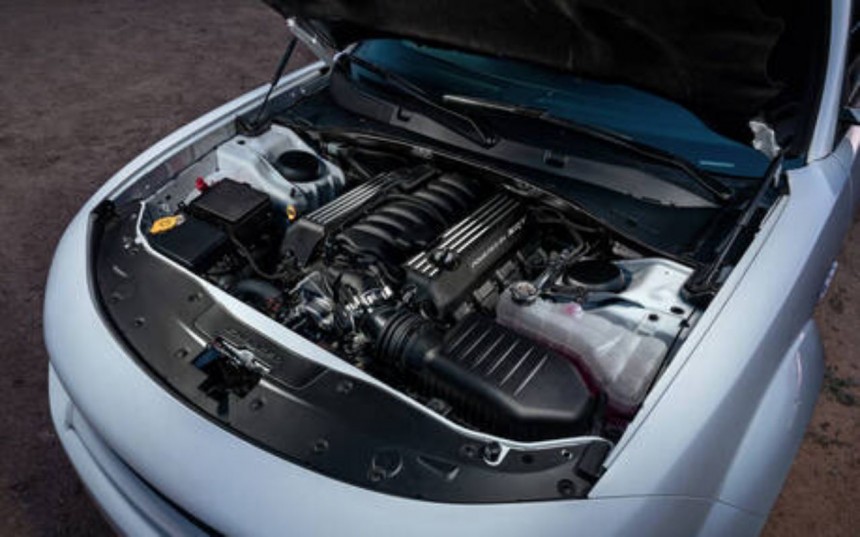Birthed in 1950, the HEMI V8 engine embarked on an astounding seven-decade journey across three generations! Chrysler Corporation's birth child, the lauded V8 engine, was engineered to counter GM's imposing 5.0-liter Rocket 88 performance V8 and Ford's ill-starred Flathead V8 engine. Faced with a formidable challenge, Chrysler was not without an ace in the hole.
Present and past, the HEMI V8 engine utilizes eight combustion chambers shaped like half-spheres, enabling Chrysler to incorporate larger valves and thus boost power. This hemispherical layout also curtails the chamber's surface area, curbing heat dissipation. Consequently, the reliable HEMI V8 design channels its superior air-fuel mixture more competently than its V8 peers, establishing the HEMI V8 engine as the epitome of power development in a V8 configuration.
Regrettably, the adored HEMI V8 formula is slated for retirement at 2023's close as Dodge plans to transition to a more efficient propulsion technology to supersede the growingly problematic V8 engines of the present. Nevertheless, this is an opportune moment to survey the impressive lifespan of the HEMI V8 engine, the heart of automotive giants from Dodge and Plymouth to robust RAM pickups and the divisive SUVs from Jeep.
Marking its debut under a distinct moniker, the Firepower V8, Chrysler launched their maiden HEMI V8 engine in 1951, leveraging their military expertise in crafting hemispherical engines. The 331 (5.4-liter) V8 generated a robust 180 hp, driving emblematic Chrysler models like the New Yorker and even the doomed Imperial marque. Worth mentioning is that Ford's Flathead V8 mustered about 110 hp, and GM's Rocket 88 peaked at 135 horsepower in 1951, effectively crowning Chrysler's engine as the king of V8s amongst the big three.
In a fascinating turn of events, the Firepower V8 was chosen to fuel the world's most deafening siren! Constructed between 1952-1957, the Chrysler Air Raid Siren unleashes a head-splitting 138 decibels powered by a 5.4-liter Firepower HEMI V8 engine. Leaving sirens behind, the Firepower V8 HEMI engine found its home in only three of Chrysler's four automobile brands.
Chrysler and its subsequent luxury brand "Imperial" wielded Firepower V8 engines varying from 5.4-6.4 liters. The mightiest made its appearance in 1957, producing an astonishing 375 hp in the Chrysler 300, with a displacement of 6.4 liters. Chrysler's endeavors soon earned a following among dragsters, thanks to their Carter WCFB dual four-barrel carburetors arrangement and hydraulic valve lifters, propelling their luxury 300 models of 1957 to an impressive 375 hp and 420 lb-ft of torque! As a matter of fact, the Chrysler 300 could sprint from 0-60 mph in roughly eight seconds in 1957!
DeSoto and Dodge also laid their hands on the Firepower HEMI V8 engine. DeSoto rechristened the V8 engine as the "Firedome" V8 but lagged behind the leading Chrysler vehicles. The DeSoto Firedome V8 peaked at 345 hp with its 1957 5.6-liter version of the HEMI V8 engine. Ironically, Dodge, by contemporary standards, fielded the least powerful variant of the first-gen HEMI V8, topping off with their "Super Red Ram" HEMI, which churned out a modest 260 hp in their Coronet and Royale models.
In 1964, the legendary 426 HEMI made its grand debut, resurrecting the hemispherical V8 engine solely for the adrenaline-fueled world of racing. Although the second iteration of the HEMI V8, this 7.0-liter beast was the first to brandish the "HEMI V8" moniker in Chrysler's promotional materials.
The 426 HEMI V8 swiftly carved out a name for itself, clinching victories in the NASCAR championship steered by race car legends like Richard Petty and David Pearson. Chrysler cleverly installed this hulk, aptly named the "Elephant," into Plymouth Belvedere models. Fortunately for automotive enthusiasts, NASCAR soon outlawed this behemoth of an engine. Chrysler's second-generation HEMI engines, with their thunderous 425 hp and 490 lb-ft of torque, proved too overpowering for NASCAR. Regrettably, grievances from Ford and altered homologation rules nudged the colossal 800 lb V8 engine out of the 1965 NASCAR season. This forced Chrysler to conceive production variants of the notorious HEMI V8 to reclaim their position on the track. This resulted in the creation of the A102 Street HEMI, the power behind some of the most iconic muscle cars from 1966 to 1971.
The Street HEMI V8, a marvel from Chrysler, was equipped with dual four-barrel AFB carburetors and featured a reduced compression ratio of 10.25:1, as compared to its racing twin's 12.5:1. The advent of this street variant enabled the HEMI to race once again in the 1966 season. Several muscle cars equipped with the 426 HEMI are considered rare treasures today. These include the Dodge Dart HEMI, Dodge Charger R/T, Plymouth Superbird, and Plymouth Cuda. The 426 HEMI engine, arriving in limited quantities, propelled Mopar's finest muscle cars from 0-60 mph in approximately five seconds while breezing through the quarter-mile in less than 14 seconds. Alas, the infamous "oil crisis" signaled the end of the revered 426 HEMI V8 post-1971.
Fast forward to 2003, the HEMI V8 engine made a triumphant comeback under the supervision of DaimlerChrysler, replacing the Magnum engine series and reinstating Chrysler's old-time charm. The reborn "Eagle" HEMI sported a two-valve pushrod design, combined with an electronic throttle control system, and generated a robust 345 hp from its 5.7-liter displacement.
Subsequently, the revived HEMI expanded to 6.1 liters for SRT-branded models, incorporating a forged crankshaft and lighter pistons. Further enhancements to the 6.1-liter variant included a cast aluminum intake manifold and an entirely redesigned coolant circulation system to boost the performance block. Remarkably, the 6.1-liter HEMI V8 churned out a nostalgic 425 hp at 6,200 RPM, reminiscent of its 426 HEMI forebear.
A successor to the previous engines, the "Apache" HEMI V8 was launched in 2011 and found its home in a select number of vehicles boasting the "392 HEMI" badge. This 6.4-liter version of the Eagle HEMI is a respectful nod to the HEMI V8 engines of the past, delivering a robust 525 hp, courtesy of its enhanced high-strength forged aluminum pistons. The 392 HEMI swapped places with the 6.1-liter performance V8, making appearances in select SRT models, including the Durango and Challenger SRT 392 models. Intriguingly, the Apache HEMI also stepped into the shoes of the 5.7-liter HEMI engine in Cab-Chassis RAM Pickup trucks post-2016.
In 2015, Dodge broke new ground by releasing the world's mightiest production V8 engine, the Hellcat HEMI V8. Making its debut in the 2015 Dodge Challenger SRT Hellcat, it unfurled an earth-shattering 707 hp and 650 lb-ft of torque. The Hellcat HEMI revolutionized the landscape, drawing its awe-inspiring power from a 2.4-liter supercharger. A host of forged steel components, such as its crankshaft and connecting rods, reinforce the Hellcat HEMI V8, while Dodge also introduced forged aluminum pistons and a revamped high-flow cooling system, keeping the wild V8 in harmony with the most reliable Dodge vehicles.
Fast forward to 2023, the Hellcat HEMI V8 now flexes its muscles with 717 hp under the hoods of Charger/Challenger muscle cars, enabling them to hit 60 mph in a mere 3.6 seconds! But the third-gen HEMI V8 engine saga doesn't stop here. The Hellcat set the stage for another iconic HEMI V8 engine, the pinnacle of the HEMI V8 lineage – the Demon, named after the company's 1970 muscle car. The Demon V8's supercharger was expanded to 2.7 liters over its Hellcat sibling, and the cooling system was revamped to support the Demon's colossal 808 hp and 717 lb-ft of torque! With 100-octane gasoline, the Demon's HEMI V8 can unleash an astounding 840 hp. The Demon HEMI boasts a lightning-fast 0-60 mph time of just 2.3 seconds, securing its title as the world's most potent production V8 at launch!
Yet, there's one final chapter to this tale. The 2023 Demon D170 HEMI V8 is the ultimate performance block bearing the HEMI moniker. This iconic V8 churns out a staggering 1,025 hp and 945 lb-ft of torque from its 6.2-liter supercharged block! Sharing inspiration with the company's C170 Hellephant crate engine, the D170 HEMI flaunts a gigantic 3.0-liter supercharger alongside a suite of "aerospace-grade" high-strength steel parts, catapulting the Dodge Demon D170 from 0-60 mph in an unfathomable 1.66 seconds! The Demon D170 already owns an NHRA production record, smashing the quarter mile in 8.91 seconds. The D170 HEMI V8 is the most powerful production V8 engine ever created. Regrettably, after a 73-year legacy of record-smashing, the D170 marks the end of the HEMI V8 lineage.
Regrettably, the adored HEMI V8 formula is slated for retirement at 2023's close as Dodge plans to transition to a more efficient propulsion technology to supersede the growingly problematic V8 engines of the present. Nevertheless, this is an opportune moment to survey the impressive lifespan of the HEMI V8 engine, the heart of automotive giants from Dodge and Plymouth to robust RAM pickups and the divisive SUVs from Jeep.
Marking its debut under a distinct moniker, the Firepower V8, Chrysler launched their maiden HEMI V8 engine in 1951, leveraging their military expertise in crafting hemispherical engines. The 331 (5.4-liter) V8 generated a robust 180 hp, driving emblematic Chrysler models like the New Yorker and even the doomed Imperial marque. Worth mentioning is that Ford's Flathead V8 mustered about 110 hp, and GM's Rocket 88 peaked at 135 horsepower in 1951, effectively crowning Chrysler's engine as the king of V8s amongst the big three.
In a fascinating turn of events, the Firepower V8 was chosen to fuel the world's most deafening siren! Constructed between 1952-1957, the Chrysler Air Raid Siren unleashes a head-splitting 138 decibels powered by a 5.4-liter Firepower HEMI V8 engine. Leaving sirens behind, the Firepower V8 HEMI engine found its home in only three of Chrysler's four automobile brands.
DeSoto and Dodge also laid their hands on the Firepower HEMI V8 engine. DeSoto rechristened the V8 engine as the "Firedome" V8 but lagged behind the leading Chrysler vehicles. The DeSoto Firedome V8 peaked at 345 hp with its 1957 5.6-liter version of the HEMI V8 engine. Ironically, Dodge, by contemporary standards, fielded the least powerful variant of the first-gen HEMI V8, topping off with their "Super Red Ram" HEMI, which churned out a modest 260 hp in their Coronet and Royale models.
In 1964, the legendary 426 HEMI made its grand debut, resurrecting the hemispherical V8 engine solely for the adrenaline-fueled world of racing. Although the second iteration of the HEMI V8, this 7.0-liter beast was the first to brandish the "HEMI V8" moniker in Chrysler's promotional materials.
The 426 HEMI V8 swiftly carved out a name for itself, clinching victories in the NASCAR championship steered by race car legends like Richard Petty and David Pearson. Chrysler cleverly installed this hulk, aptly named the "Elephant," into Plymouth Belvedere models. Fortunately for automotive enthusiasts, NASCAR soon outlawed this behemoth of an engine. Chrysler's second-generation HEMI engines, with their thunderous 425 hp and 490 lb-ft of torque, proved too overpowering for NASCAR. Regrettably, grievances from Ford and altered homologation rules nudged the colossal 800 lb V8 engine out of the 1965 NASCAR season. This forced Chrysler to conceive production variants of the notorious HEMI V8 to reclaim their position on the track. This resulted in the creation of the A102 Street HEMI, the power behind some of the most iconic muscle cars from 1966 to 1971.
Fast forward to 2003, the HEMI V8 engine made a triumphant comeback under the supervision of DaimlerChrysler, replacing the Magnum engine series and reinstating Chrysler's old-time charm. The reborn "Eagle" HEMI sported a two-valve pushrod design, combined with an electronic throttle control system, and generated a robust 345 hp from its 5.7-liter displacement.
Subsequently, the revived HEMI expanded to 6.1 liters for SRT-branded models, incorporating a forged crankshaft and lighter pistons. Further enhancements to the 6.1-liter variant included a cast aluminum intake manifold and an entirely redesigned coolant circulation system to boost the performance block. Remarkably, the 6.1-liter HEMI V8 churned out a nostalgic 425 hp at 6,200 RPM, reminiscent of its 426 HEMI forebear.
A successor to the previous engines, the "Apache" HEMI V8 was launched in 2011 and found its home in a select number of vehicles boasting the "392 HEMI" badge. This 6.4-liter version of the Eagle HEMI is a respectful nod to the HEMI V8 engines of the past, delivering a robust 525 hp, courtesy of its enhanced high-strength forged aluminum pistons. The 392 HEMI swapped places with the 6.1-liter performance V8, making appearances in select SRT models, including the Durango and Challenger SRT 392 models. Intriguingly, the Apache HEMI also stepped into the shoes of the 5.7-liter HEMI engine in Cab-Chassis RAM Pickup trucks post-2016.
Fast forward to 2023, the Hellcat HEMI V8 now flexes its muscles with 717 hp under the hoods of Charger/Challenger muscle cars, enabling them to hit 60 mph in a mere 3.6 seconds! But the third-gen HEMI V8 engine saga doesn't stop here. The Hellcat set the stage for another iconic HEMI V8 engine, the pinnacle of the HEMI V8 lineage – the Demon, named after the company's 1970 muscle car. The Demon V8's supercharger was expanded to 2.7 liters over its Hellcat sibling, and the cooling system was revamped to support the Demon's colossal 808 hp and 717 lb-ft of torque! With 100-octane gasoline, the Demon's HEMI V8 can unleash an astounding 840 hp. The Demon HEMI boasts a lightning-fast 0-60 mph time of just 2.3 seconds, securing its title as the world's most potent production V8 at launch!
Yet, there's one final chapter to this tale. The 2023 Demon D170 HEMI V8 is the ultimate performance block bearing the HEMI moniker. This iconic V8 churns out a staggering 1,025 hp and 945 lb-ft of torque from its 6.2-liter supercharged block! Sharing inspiration with the company's C170 Hellephant crate engine, the D170 HEMI flaunts a gigantic 3.0-liter supercharger alongside a suite of "aerospace-grade" high-strength steel parts, catapulting the Dodge Demon D170 from 0-60 mph in an unfathomable 1.66 seconds! The Demon D170 already owns an NHRA production record, smashing the quarter mile in 8.91 seconds. The D170 HEMI V8 is the most powerful production V8 engine ever created. Regrettably, after a 73-year legacy of record-smashing, the D170 marks the end of the HEMI V8 lineage.




